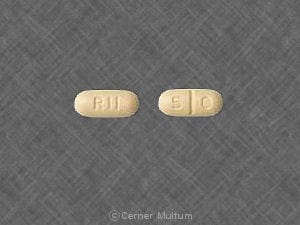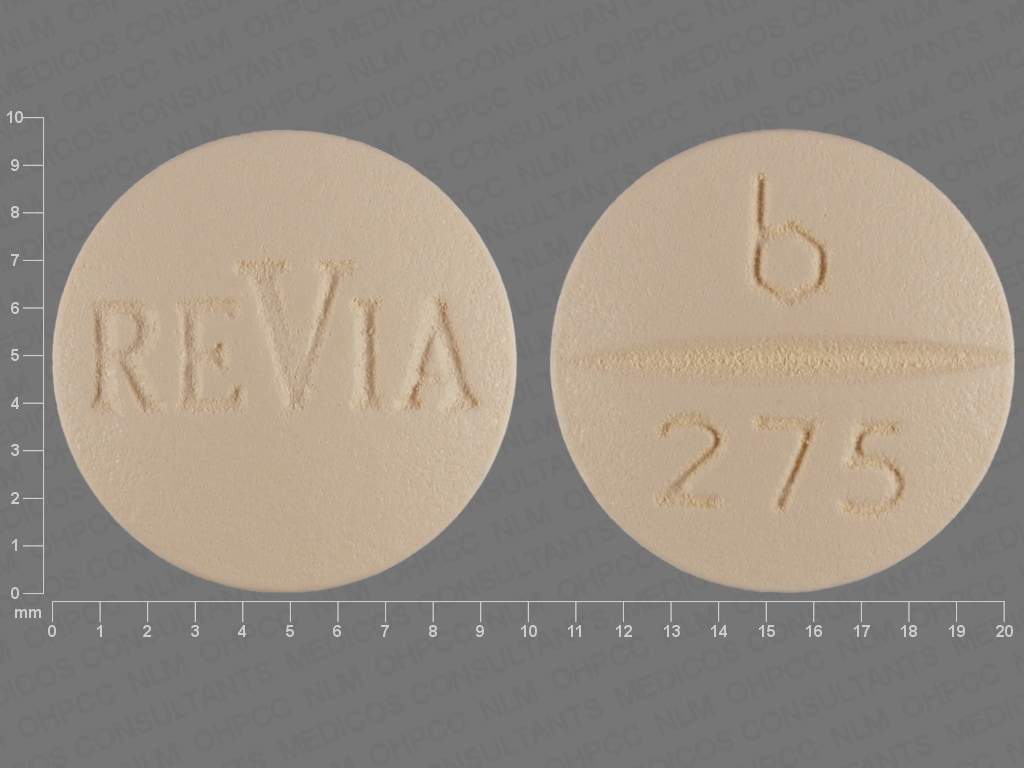What is naltrexone?
Naltrexone hydrochloride tablets are used in the treatment of alcohol dependence and for the blockade of the effects of exogenously administered opioids.
Naltrexone has not been shown to provide any therapeutic benefit except as part of an appropriate plan of management for the addictions.
Naltrexone should not be used in children and adolescents under 18 years of age, since clinical data in this age group are lacking. Safe use in children has not been established.
What is the most important information I should know about naltrexone?
- Naltrexone treatment must begin only when the opioid has been discontinued for a sufficiently long period (about 5 to 7 days for heroin and at least 10 days for methadone).
- You should carry identification to alert medical personnel to the fact that you are taking naltrexone. A naltrexone medication card may be obtained from your physician and can be used for this purpose. Carrying the identification card should help to ensure that you can obtain adequate treatment in an emergency. If you require medical treatment, be sure to tell the treating physician that you are receiving naltrexone therapy.
- If you need opioid treatment, for example an opioid analgesic or anesthesia in emergency situation, the opioid dose will need to be higher to achieve the same therapeutic effect. In these cases respiratory depression and circulatory effect will be more profound and longer lasting.
- Liver function test abnormalities have been reported in obese and elderly patients taking naltrexone who have no history of drug abuse.
It is important to stop taking naltrexone immediately and to tell your healthcare provider if you develop the following symptoms:- Persistent abdominal pain
- White stools
- Dark urine
- Your eyes and/or skin turn yellow.
Who should not take naltrexone?
Do not take naltrexone tablets:
- If you are allergic to naltrexone hydrochloride or any of the other ingredients in tablet formulation you take. See below for a complete list of ingredients.
- If you are dependent on opiates or are undergoing treatment involving abstinence (self denial), since abstinence syndrome or an exacerbation of abstinence syndrome can occur.
- If you are continuously using a medicinal product containing an opioid, for example certain cough medicines, medicines to treat diarrhoea (such as kaolin and morphine) and analgesics (pain killers).
Note: Naltrexone hydrochloride does not have a blocking effect on analgesics which do not contain any opioids (such as ibuprofen, paracetamol and acetylsalicylic acid). - If you have an acute liver infection or if your liver function is poor.
- If patients have withdrawal symptoms after naloxone hydrochloride administration.
- If you take methadone.
- If you think any of these apply to you, do not take naltrexone. Talk to your healthcare provider first and follow their advice.
What should I tell my healthcare provider before taking naltrexone?
Before you take naltrexone, tell your healthcare provider about all of your medical conditions, including if you:
- Have liver or kidney diseases. Patients who have used naltrexone tablets can still have hypersensitivity reactions when taking medicines containing opiates, even in the period after use. Before starting treatment your doctor may carry out a blood test. Blood tests are also necessary during treatment, because this medications is processed by the liver and these tests show how well your liver is working.
- Are still taking an opioid, have recently taken or might have recently taken an opioid. Naltrexone treatment must begin only when the opioid has been discontinued for a sufficiently long period (about 5 to 7 days for heroin and at least 10 days for methadone). Simultaneous use of naltrexone and medicines containing opiates must be avoided. If you try to overcome the blocking action of naltrexone with large quantities of opioids, you will find yourself in great difficulties. Such action can lead to:
- Breathlessness
- Coma
- Death
- Take thioridazine. Simultaneous use of naltrexone and thioridazine can cause drowsiness.
- Are pregnant or plan to become pregnant. It is not known if this medication will harm your unborn baby. It should only be used during pregnancy if the potential benefits justifies the potential risk to the baby.
- Are breastfeeding or plan to breastfeed. Breastfeeding is not recommended while taking naltrexone. Talk to your doctor about the best way to feed your baby while you are on this medication.
How should I take naltrexone tablets?
- Always take naltrexone tablets exactly as your healthcare provider tells you to. Check with them if you are not sure.
- Take naltrexone tablets by mouth once daily with a small amount of water.
- The usual starting dose is generally half a tablet (25 mg) daily, before increasing your dose to 1 tablet (50 mg) daily. Your healthcare provider will tell you how much to take.
- Before starting this medication you must not have used any opioids for at least 7 to 10 days. Tests may be carried out to see if you are opioid-free before starting you on naltrexone.
- Naltrexone treatment may last for 3 months or longer. Your healthcare provider will tell you how long you should take this medication for.
- If you miss a dose you should take it when you remember. However, if it is almost time for your next dose, skip the missed dose. Do not take a double dose to make up for a missed dose.
- If you take more naltrexone than you have been prescribed, contact you healthcare provider right away.
- Do not stop taking this medication without talking to your healthcare provider first.
What should I avoid while taking naltrexone?
Avoid driving, operating machinery or carrying out other dangerous activities until you know how naltrexone affects you. This medication may make you feel sleepy or dizzy.
What are the possible side effects of naltrexone?
Naltrexone may cause serious side effects including:
- Liver injury. Stop taking naltrexone and contact your healthcare provider right away if you develop any of the following symptoms:
- Abdominal pain lasting more than a few days
- White bowel movements
- Dark urine
- Yellowing of your eyes
- Allergic reactions. Tell you healthcare provider right away if you develop any of the following symptoms:
- Swelling of the face, lips, or tongue
- Skin rash
- Difficulty breathing
Common side effects of naltrexone include:
- Difficulty sleeping
- Anxiety or nervousness
- Abdominal cramps and pain
- Nausea and/or vomiting
- Lack of energy or strength
- Joint and/or muscle pain
- Headaches
- Fast or irregular heartbeat
- Restlessness
- Irritability
- Mood swings
- Increased energy
- Despondency
- Dizziness
- Shivering
- Increased or excessive sweating
- Vertigo
- Increased lacrimation
- Increased heart beat
- Palpitations
- Change in ECG readings
- Pain in the chest
- Diarrhea
- Constipation
- Rash
- Urine retention
- Delayed ejaculation
- Erectile dysfunction
- Lack of appetite
- Thirst
- Energy increased
- Chills
These are not all the possible side effects of this medication. Tell your healthcare provider if you have any side effects that bother you or do not go away. Call your healthcare provider for medical advice about side effects. You may report side effects to FDA at 1-800-FDA-1088.
Naltrexone tablets Images
General information about the safe and effective use of naltrexone
Medicines are sometimes prescribed for purposes other than those listed here. Do not use naltrexone for a condition for which it was not prescribed. Do not give this medication to other people, even if they have the same symptoms you have. It may harm them. You can ask your pharmacist or healthcare provider for information about this medication that is written for health professionals.
How should I store naltrexone?
- Store tablets at 20° to 25°C (68° to 77°F)
- Store in an airtight container
Keep out of sight and reach of children.
What are the ingredients in naltrexone tablets?
Active ingredients: naltrexone hydrochloride
Inactive ingredients:
Inactive ingredients vary among the different generic versions of this medication.
Accord Healthcare tablets: colloidal anhydrous silica, crospovidone, hydroxypropyl methylcellulose, lactose monohydrate, magnesium stearate, microcrystalline cellulose, polyethylene glycol 400, polysorbate 80, iron oxide red, iron oxide yellow and titanium dioxide.
Chartwell tablets: lactose monohydrate, hypromellose, magnesium stearate, polyethylene glycol, titanium dioxide, colloidal silicon dioxide, hydroxypropyl cellulose, yellow ferric oxide and red ferric oxide.
Elite Labs tablets: carnauba wax powder, colloidal silicon dioxide, croscarmellose sodium, hypromellose, hydroxypropyl cellulose, lactose anhydrous, magnesium stearate, microcrystalline cellulose, polyethylene glycol, titanium dioxide and yellow iron oxide.
SpecGx tablets: crospovidone, hydroxypropyl methylcellulose, lactose monohydrate, magnesium stearate, microcrystalline cellulose, polyethylene glycol, polysorbate 80, silicon dioxide, titanium dioxide, yellow iron oxide and red iron oxide.
Sun Pharmaceutical tablets: lactose monohydrate, microcrystalline cellulose, colloidal silicon dioxide, crospovidone, magnesium stearate, hypromellose, titanium dioxide, polyethylene glycol, iron oxide yellow, polysorbate 80 and iron oxide red.







